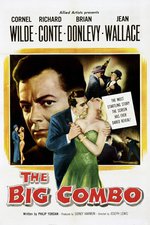The Big Combo (1955)
March 3, 2016 10:26 PM - Subscribe
A police lieutenant is ordered to stop investigating deadly crime boss Mr. Brown, because he hasn't been able to get any hard evidence against him. He then goes after Brown's girlfriend, who despises him, for information instead. Full movie here on YouTube.
Original 1955 NYTimes Review: "THE Big Combo," an Allied Artists release that opened yesterday with the Palace's new stage bill, isn't very big or good. Even with the "combo" of a capable cast, headed by Cornel Wilde and Richard Conte, and the kernel of a provocative plot, the result is a shrill, clumsy and rather old-fashioned crime melodrama with all hands pulling in opposite directions.
Film Noir of the Week: he heart of the film centers on a triangle between Mr. Brown, a hood played with venomous glee by Richard Conte, his weak-willed society girlfriend, Susan Lowell (Jean Wallace), and Leonard Diamond (Wallace’s then-husband Cornel Wilde), a police detective who is driven both by his obsession for Susan and his determination to bring Mr. Brown to justice. Ultimately, Diamond gets his man and the girl, but it is the characters, rather than the plot, that make this film so unforgettable.
The Dissolve: But John Alton’s camerawork is what truly sets it apart. The influential, Hungarian-born cinematographer had worked in noir before, but here, he seems determined to deliver a master class in noir style, filling the screen with deep shadows, piercing beams of light, and creeping fogs. Lewis uses his work to great effect. A few scenes spin in circles as the plot works toward not-so-shocking revelations, but the film’s back half is littered with memorable setpieces, including a torture scene involving a hearing aid, hair tonic, and pounding jazz music, and a pair of scenes set in an airline hangar that pay homage to Casablanca’s finale. Alton gives the film a classic noir look, but the combined efforts give the film a classic noir feel, a sense that goodness rarely triumphs over corruption, and that the world is governed by rules as black-and-white as the film. “First is first,” Brown is fond of saying, “and second is nobody,” and little within the film proves him wrong. Noir wasn’t new in 1955, but The Big Combo still found plenty of life within its limits.
Senses of Cinema: But it is precisely the ‘exploitative’ elements, the overt and implied expressions of sex and violence, that give The Big Combo its tensile and decidedly contemporary appeal. Distinguished by complex plotting, the film’s multiple relationships are defined by varying degrees of sexual obsession. From the amusingly fractious relationship between Brown’s conspicuously gay hitmen Fante (Lee Van Cleef) and Mingo (Earl Holliman), to Diamond’s quasi-sadistic dealings with both Rita and Susan, Lewis makes clear that The Big Combo is as much concerned with the dynamics of power, money and sexuality, as with the nexus between business, crime and the forces of law and order.
Original 1955 NYTimes Review: "THE Big Combo," an Allied Artists release that opened yesterday with the Palace's new stage bill, isn't very big or good. Even with the "combo" of a capable cast, headed by Cornel Wilde and Richard Conte, and the kernel of a provocative plot, the result is a shrill, clumsy and rather old-fashioned crime melodrama with all hands pulling in opposite directions.
Film Noir of the Week: he heart of the film centers on a triangle between Mr. Brown, a hood played with venomous glee by Richard Conte, his weak-willed society girlfriend, Susan Lowell (Jean Wallace), and Leonard Diamond (Wallace’s then-husband Cornel Wilde), a police detective who is driven both by his obsession for Susan and his determination to bring Mr. Brown to justice. Ultimately, Diamond gets his man and the girl, but it is the characters, rather than the plot, that make this film so unforgettable.
The Dissolve: But John Alton’s camerawork is what truly sets it apart. The influential, Hungarian-born cinematographer had worked in noir before, but here, he seems determined to deliver a master class in noir style, filling the screen with deep shadows, piercing beams of light, and creeping fogs. Lewis uses his work to great effect. A few scenes spin in circles as the plot works toward not-so-shocking revelations, but the film’s back half is littered with memorable setpieces, including a torture scene involving a hearing aid, hair tonic, and pounding jazz music, and a pair of scenes set in an airline hangar that pay homage to Casablanca’s finale. Alton gives the film a classic noir look, but the combined efforts give the film a classic noir feel, a sense that goodness rarely triumphs over corruption, and that the world is governed by rules as black-and-white as the film. “First is first,” Brown is fond of saying, “and second is nobody,” and little within the film proves him wrong. Noir wasn’t new in 1955, but The Big Combo still found plenty of life within its limits.
Senses of Cinema: But it is precisely the ‘exploitative’ elements, the overt and implied expressions of sex and violence, that give The Big Combo its tensile and decidedly contemporary appeal. Distinguished by complex plotting, the film’s multiple relationships are defined by varying degrees of sexual obsession. From the amusingly fractious relationship between Brown’s conspicuously gay hitmen Fante (Lee Van Cleef) and Mingo (Earl Holliman), to Diamond’s quasi-sadistic dealings with both Rita and Susan, Lewis makes clear that The Big Combo is as much concerned with the dynamics of power, money and sexuality, as with the nexus between business, crime and the forces of law and order.
You are not logged in, either login or create an account to post comments

The opening and closing shots are really awesome, too. It had been a while since I've seen it and had forgotten about that first opening scene with the woman running-really great stuff.
posted by MoonOrb at 5:01 PM on March 4, 2016 [1 favorite]